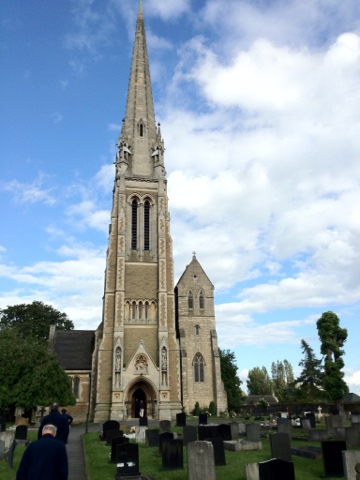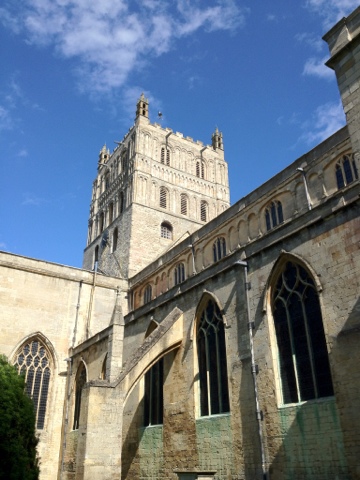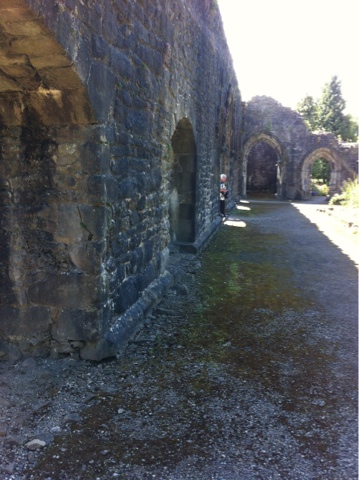My first visit to Rugby revealed in all it's glory, St Marie's Catholic Parish Church. This fine example of Pugin's Gothic Revival style stands proud on the Dunchurch Road in the midst of a large churchyard and looks every bit like an ancient CofE parish church until you get close. This must've been what it was like in England before the reformation.
The really good news is that latter day liturgical re-orderings have done very little to spoil Pugin's interior with its God-ward orientation. Only the temporary altar and the misplaced font stand out as being slightly at odds with overall style.
Pray for the soul of Cpt John Hubert Washington Hibbert, founding benefactor of the Church and the Rosminians who care for it and have done so since 1849.
Monday 25 June 2012
Tewkesbury Abbey
Yesterday I had the great joy of fulfilling the SSIM duties in glorious Tewkesbury Abbey. Built by the Benedictines it was consecrated in 1121. Our Anglican brothers and sisters obviously care greatly for the buildings which exude an atmosphere of prayer. I was reminded of a line from an Anglican hymn: "These stones that have echoed their praises are holy..."
Saturday 23 June 2012
From Aristotle to Dorothy
The English countryside is dotted with churches which had been places of Catholic worship until the horrors of the 16th century. One such is the the (now Anglican) Church of St Margaret of Antioch in the small village of Hemingford Abbots in Cambridgeshire.
The first recorded Rector, in 1200, was one Aristotle a monk of Ramsey Abbey, the current incumbent is Dorothy! I prayed for them both during a visit there today as well as all who have worshipped there down the centuries and of course the current congregation. "That they may be one".
The Font has been in continual use since 1200 to impart God's grace in the Sacrament of Baptism.
The first recorded Rector, in 1200, was one Aristotle a monk of Ramsey Abbey, the current incumbent is Dorothy! I prayed for them both during a visit there today as well as all who have worshipped there down the centuries and of course the current congregation. "That they may be one".
The Font has been in continual use since 1200 to impart God's grace in the Sacrament of Baptism.
Wednesday 20 June 2012
St Alban, Proto-martyr of Britain
Friday this week is the Feast of St Alban. What better can I do than share with you our friend, Fr Alexander Lucie-Smith's article on the Catholic Herald blog on this great saint.
http://www.catholicherald.co.uk/commentandblogs/2012/06/20/how-a-pagan-soldier-was-moved-by-the-faith-of-a-christian-priest/#.T-Hka3Fpolk.facebook
http://www.catholicherald.co.uk/commentandblogs/2012/06/20/how-a-pagan-soldier-was-moved-by-the-faith-of-a-christian-priest/#.T-Hka3Fpolk.facebook
Monday 18 June 2012
Whalley Abbey
I had the opportunity to visit the ruins of Whalley Abbey in Lancashire today as well as it's neighbouring 13th century Church of St Mary and All Saints.
The choir stalls in the church were originally made for the Abbey around 1430 and moved to the Church at the Dissolution.
The Abbey itself was a Cistercian house, having moved from Stanlow in Cheshire in 1296. The Abbey Church was completed in 1380 although the Abbot's lodging wasn't finished until 1440.
The monks sang the office in stalls over a Choir pit, which is still very clearly visible today. It is believed these covered ditches added resonance to the chant.
In 1537 the buildings passed into private ownership and a Manor House was built of the sacred stones. So it remained until it became the property of the Anglican Church in 1923. It is now the Diocese of Bradford's retreat house and they have built a new stone altar on the site of the ancient High Altar, in the midst of the ruins.
The choir stalls in the church were originally made for the Abbey around 1430 and moved to the Church at the Dissolution.
The Abbey itself was a Cistercian house, having moved from Stanlow in Cheshire in 1296. The Abbey Church was completed in 1380 although the Abbot's lodging wasn't finished until 1440.
The monks sang the office in stalls over a Choir pit, which is still very clearly visible today. It is believed these covered ditches added resonance to the chant.
In 1537 the buildings passed into private ownership and a Manor House was built of the sacred stones. So it remained until it became the property of the Anglican Church in 1923. It is now the Diocese of Bradford's retreat house and they have built a new stone altar on the site of the ancient High Altar, in the midst of the ruins.
Friday 15 June 2012
O Sacred Heart!
 |
| St Claude de la Colombiere and the Sacred Heart |
In its present form, the devotion dates to the visions of St Marguerite Marie Alacoque, which took place between 1673-75 in the convent of the Visitation sisters in Paray-le-Monial in the centre of France. The great apparition took place during the Octave of Corpus Christi in 1675 when our Lord said to Sr Margaret-Mary, "Behold the Heart that has so loved men... instead of gratitude I receive from the greater part only ingratitude" He asked her for a Feast to be instituted on this day and told her to consult her confessor about it.
That Confessor was Claude de la Colombiere, a Jesuit. Having had the vision reported to him he became one of the first to consecrate himself to the Sacred Heart and the task of spreading the devotion fell to the Visitation Sisters and to the Jesuits.
Margaret-Mary was herself canonised by Pope Benedict XV on 13 May 1902 and Fr Claude, her confessor, by Pope John Paul II on 31 May 1992.
 |
| Ss Margaret Mary and her Confessor, St Claude de la Colombiere |
In 1676, Claude was sent to Great Britain to be Chaplain to the Duchess of York (Mary of Modena) and lived the life of a religious in St James's Palace - he continued as an active missionary in these lands as he had been in France and was a zealous apostle of the devotion to the Sacred Heart.
St Claude - Pray for us!
St Margaret Mary - pray for us!
Most Sacred Heart of Jesus - Make our hearts like unto Thine Heart!
| Relic of St Claude |
Thursday 14 June 2012
Salisbury Cathedral
A member from Plymouth has been in touch to tell us that she recently visited the Cathedral of the Blessed Virgin Mary in Salisbury to recite the SSIM prayers.
The Cathedral and See moved from Old Sarum to Salisbury in the early 13thC under Bishop Richard Poore. The Cathedral was built between the years 1220 and 1258 in the Early English Gothic Style.
 The Cathedral houses the tomb of St Osmund of Salisbury, who was Bishop of Old Sarum from 1078-99. He was an Norman nobleman with the title Count of Sees and was also for a time Lord Chancellor (1070-78). Osmund was noted for building the Cathedral at Old Sarum, establishing a Cathedral governing body based on the Norman system, comprising a dean, precentor, chancellor, treasurer, 32 canons, a sub-dean and subcenter and thirdly for the formation of the 'Sarum Use' in the liturgy.
The Cathedral houses the tomb of St Osmund of Salisbury, who was Bishop of Old Sarum from 1078-99. He was an Norman nobleman with the title Count of Sees and was also for a time Lord Chancellor (1070-78). Osmund was noted for building the Cathedral at Old Sarum, establishing a Cathedral governing body based on the Norman system, comprising a dean, precentor, chancellor, treasurer, 32 canons, a sub-dean and subcenter and thirdly for the formation of the 'Sarum Use' in the liturgy.
William of Malmesbury said of Osmund: "so eminent for chastity that common fame would itself blush to speak otherwise than truthfully concerning his virtue. Stern he might appear to penitents, but not more severe to them than to himself. Free from ambition, he neither imprudently wasted his own substance, nor sought the wealth of others". He was canonised on 1 January 1457.
In 1472 Pope Sixtus IV granted an indugence to those who visit his Cathedral on his festival (4 December)
The Cathedral and See moved from Old Sarum to Salisbury in the early 13thC under Bishop Richard Poore. The Cathedral was built between the years 1220 and 1258 in the Early English Gothic Style.
 The Cathedral houses the tomb of St Osmund of Salisbury, who was Bishop of Old Sarum from 1078-99. He was an Norman nobleman with the title Count of Sees and was also for a time Lord Chancellor (1070-78). Osmund was noted for building the Cathedral at Old Sarum, establishing a Cathedral governing body based on the Norman system, comprising a dean, precentor, chancellor, treasurer, 32 canons, a sub-dean and subcenter and thirdly for the formation of the 'Sarum Use' in the liturgy.
The Cathedral houses the tomb of St Osmund of Salisbury, who was Bishop of Old Sarum from 1078-99. He was an Norman nobleman with the title Count of Sees and was also for a time Lord Chancellor (1070-78). Osmund was noted for building the Cathedral at Old Sarum, establishing a Cathedral governing body based on the Norman system, comprising a dean, precentor, chancellor, treasurer, 32 canons, a sub-dean and subcenter and thirdly for the formation of the 'Sarum Use' in the liturgy.William of Malmesbury said of Osmund: "so eminent for chastity that common fame would itself blush to speak otherwise than truthfully concerning his virtue. Stern he might appear to penitents, but not more severe to them than to himself. Free from ambition, he neither imprudently wasted his own substance, nor sought the wealth of others". He was canonised on 1 January 1457.
In 1472 Pope Sixtus IV granted an indugence to those who visit his Cathedral on his festival (4 December)
Wednesday 13 June 2012
Going to the Olympics?
Anyone attending the Olympic Stadium, in Stratford might also consider visiting All Saints Church, West Ham which stands in the middle of the one way system in Stratford centre. This from their website:
All Saints' Church is one of Newham's finest buildings which dates back a thousand years. To many in this area, it is known affectionately as the Cathedral of the East End - and rightly so. This dignified building has watched over the great developments of our history. Once associated with Stratford Langthorne Abbey, it has been linked with the crown both in fact and legend. It is said that Henry VIII used to visit the church with Anne Boleyn on their visits to the Abbey (there is a Boleyn Road nearby).
The Abbot of the Abbey was originally the patron of the church and one of the Abbots baptised Queen Elizabeth I and also went to Greenwich to welcome Anne of Cleves in 1539. The church witnessed the plague and the Great Fire of London would have been clearly seen from its majestic tower. Charles Dickens used to set his watch by the time on the church clock - the mechanism is thought by some to be the prototype of the world's most famous clock - Big Ben, at Westminster. The earliest schools were built within the churchyard and many daughter churches were established throughout Newham.
All Saints' Church is one of Newham's finest buildings which dates back a thousand years. To many in this area, it is known affectionately as the Cathedral of the East End - and rightly so. This dignified building has watched over the great developments of our history. Once associated with Stratford Langthorne Abbey, it has been linked with the crown both in fact and legend. It is said that Henry VIII used to visit the church with Anne Boleyn on their visits to the Abbey (there is a Boleyn Road nearby).
The Abbot of the Abbey was originally the patron of the church and one of the Abbots baptised Queen Elizabeth I and also went to Greenwich to welcome Anne of Cleves in 1539. The church witnessed the plague and the Great Fire of London would have been clearly seen from its majestic tower. Charles Dickens used to set his watch by the time on the church clock - the mechanism is thought by some to be the prototype of the world's most famous clock - Big Ben, at Westminster. The earliest schools were built within the churchyard and many daughter churches were established throughout Newham.
Saturday 9 June 2012
St Columba, Abbot of Iona
In the ordinary form of the Roman Rite today is the feast of St Columba, that most Celtic of our forefathers in the faith. Here is his entry in the Catholic Encyclopaedia.
St Columba
St Columba pray for us; that we may be made worthy of the promises of Christ!
St Columba
St Columba pray for us; that we may be made worthy of the promises of Christ!
Friday 8 June 2012
Westminster Abbey Chapel of the Pyx
I posted on Facebook the other day, the comments of a member who had recently visited Westminster Abbey to pray for the Queen. The first church on the site is said to have been founded in AD616 by Serbert, King of the East Saxons. This was replaced by a Benedictine Abbey in AD960, built by St Dunstan (Abbot of Galstonbury and later Archbishop of Canterbury) and we know that every Sovereign since William the Conqueror in 1066 has been crowned in the present building built by King Edward the Confessor (1042-1066).
 The Coronation Service used in 1953 for Elizabeth II was very similar to that used for William in 1066 save that latin had been abandoned around 1603.
The Coronation Service used in 1953 for Elizabeth II was very similar to that used for William in 1066 save that latin had been abandoned around 1603.
A site of Catholic worship from AD616 until the dissolution of the monasteries, it is now a Royal Peculiar, that is under the jurisdiction of Her Majesty rather than the Church of England per se.
The Abbey houses the relics of St Edward Confessor, the site of the Shrine of Our Lady of Pew and the pre-reformation stone altar, mentioned by our member, in the Chamber of the Pyx (the Pyx being the locked chest in which the Royal Treasury was secured) amongst many other items of interest to the Catholic pilgrim.
The present Statue of Our Lady of Pew was carved in 1971 in alabaster by Mother Concordia of Minster Abbey (Thanet) and is a copy of the more ancient statue in Westminster Cathedral, which was placed there as Our Lady of Westminster in 1955. This devotion to Our Lady of Pew/Our Lady of Westminster is linked by some to the origins of referring to England as the Dowry of Mary.
The Shrine of St Edward was torn down around 1540 when the abbey became a Cathedral and the monks were expelled. The monastery was re-established by Queen Mary between 1556-60 after which Elizabeth I replaced them with a chapter of twelve canons, led by a Dean.
Pray for the souls of the monks and faithful who worshipped in the Abbey Church of St Peter, those who adorned it with their generosity and their prayers and for the present Anglican Canons that, in God's time, they may be united with us in the one true fold of the redeemer.
St Edward Confessor - pray for us!
St Peter - pray for us!
Our Lady of Pew - pray for us!
Blogging again
Facebook, twitter and blogging whilst valuable in terms of keeping in touch, all take time and now that I have a little more time on my hands than I did, I hope to be more assiduous in keeping this SSIM blog up to date. Please contribute here and on our Facebook page
Subscribe to:
Posts (Atom)











